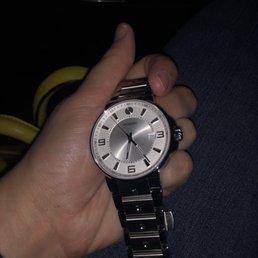

The lume on the dial has developed patina and aged nicely. The dial is clean with light patina the hands and hour markers have developed light patina in general. A personal caseback engraving from a previous owner reads "AND EVER CATHY." There are some light scratches on the caseback, particularly around the edge from being opened. The case is strong with some light scratches. This Movado is in overall great condition. The Fine Print Maker: Movadoĭimensions: 35.5mm width x 39mm height 11mm thicknessĬaliber: Movado, self-winding, caliber 405īracelet/Strap: HODINKEE The Bedford Watch Strap In Sand We paired this Tiffany signed Movado with our Bedford Strap in Sand to play off of that creamy lume patina the look is really stunning on the wrist. On the hands and on each hour marker is a bit of tritium lume that has aged wonderfully to a nice creamy tone. At 35.5mm wide by 39mm high and only 11mm thick, this Kingmatic sits so comfortably on the wrist with a slim profile but added presence due to the thick cushion "lugs." The dial is very well finished and shines in the light with a vertical brushed silver surface and applied details throughout. All the details come together so well and never feel out-of-date but, rather, extremely contemporary even in 2021. We love the way these futuristic designs have aged. With the stainless steel, cushion-shaped case and overall dial design, Movado's transition to quality, hard-wearing everyday watches in this period shines through. In the crisp Tiffany stamp at 12 o'clock, we see the brand's decades-long history in the American market through its relationship with one of the highest jewelry houses in the industry. The Tiffany signed Movado Kingmatic HS 360 we have here today dates to the late 1960s to early 1970s, around that time of the Zenith merger, and represents the era of this brand so well. Although the case and designs wrapped around the movements changed, Movado continued to produce many in-house calibers at an extremely high level of watchmaking. Rather than most of its timepieces being made in gold and precious metals, the brand created simple, sport offerings, many of which were water-resistant and stainless steel. By the late 1960s and early 1970s, Movado changed its brand strategy.

At the outset, Movado was playing near the top of the market with proprietary and in-house movement tech and exquisite finishing at the level of Switzerland's best. Movado's product line changed a lot during the time in which it was in partnership with Tiffany. Beyond FDR's triple date, Tiffany-signed Movados are highlighted by 1950s M90 and M95 chronographs as well as Ermeto "purse watches" that wound by opening and closing the outer case to reveal a hidden dial. Perhaps the most famous watch to result from their partnership was the 1944 triple calendar in gold that was worn by Franklin Delano Roosevelt during his presidency. In the early 20th century, the company established a partnership in the United States, a leading market for the brand, with one of the world's biggest names in jewelry, Tiffany & Co.
#MOVADO WATCH COMPANY PROFESSIONAL#
Among its historic catalog are stunning dress watches, professional tool watches, design-driven releases, and entry-level models. Movado was founded in 1881, and ever since, it's been known as one of Switzerland's most diverse watch brands from a product perspective. The company is still in business today.Why This Watch Matters The ultimate "look closer" detail, this Movado hides in plain sight with a Tiffany & Co. and eventually became part of the Movado Group. In 1983, Movado was acquired by North American Watch Corp. Movado also worked with artists like Salvador Dali and Andy Warhol, among others, to produce many genuinely unique timepieces. It was the first watch dial to become part of the Museum of Modern Art's permanent collection in New York City. The timepiece with a single dot on a black face. However, Movado's real claim to fame came in 1947 when Nathan George Horwitt designed the Movado Museum Watch. It was made in a case that was devised to self-wind the watch when it was opened and closed. The business followed up with another innovation in 1927, an Art Deco pocket watch called Ermeto. It was made with a complicated movement patented by the company. In 1912, Movado introduced a watch curved to the wrist called Polyplan. Several of Movado's designs are named in Esperanto, including the Luno and Juro models, translating to "moon' and "law," respectively. It wasn’t until 1905 that the expanding business was renamed Movado, which translates to “always in motion” in the international language Esperanto. He won a prize in 1900 at a Parisian exhibition for his efforts. Ditesheim’s workshop, which employed six watchmakers, was located in La Chaux-de-Fonds, Switzerland. The company that became Movado, LAI Ditesheim Freres SA, was founded by Achilles Ditesheim in 1881.


 0 kommentar(er)
0 kommentar(er)
